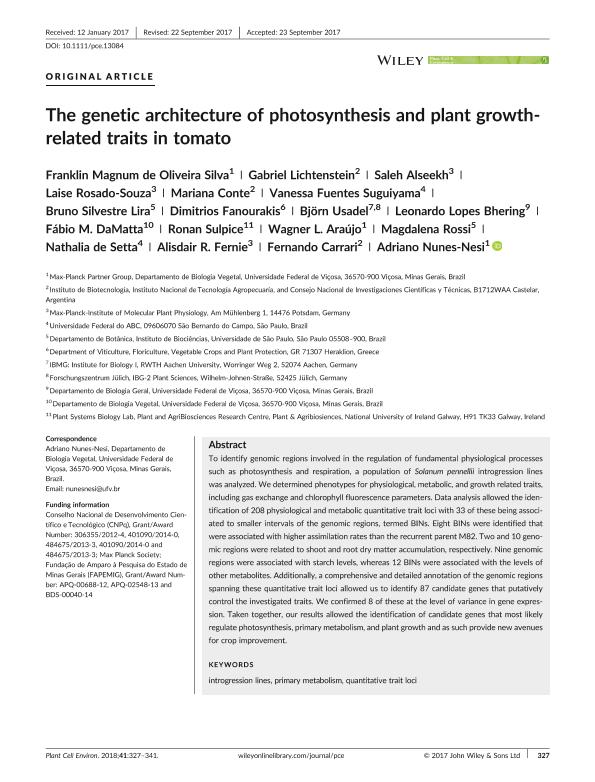Mostrar el registro sencillo del ítem
dc.contributor.author
de Oliveira Silva, Franklin Magnum
dc.contributor.author
Lichtenstein, Gabriel

dc.contributor.author
Alseekh, Saleh
dc.contributor.author
Rosado Souza, Laise
dc.contributor.author
Conte, Mariana
dc.contributor.author
Suguiyama, Vanessa Fuentes
dc.contributor.author
Lira, Bruno Silvestre
dc.contributor.author
Fanourakis, Dimitrios
dc.contributor.author
Usadel, Björn
dc.contributor.author
Bhering, Leonardo Lopes
dc.contributor.author
DaMatta, Fábio M.
dc.contributor.author
Sulpice, Ronan
dc.contributor.author
Araújo, Wagner L.
dc.contributor.author
Rossi, Magdalena
dc.contributor.author
de Setta, Nathalia
dc.contributor.author
Fernie, Alisdair R.
dc.contributor.author
Carrari, Fernando Oscar

dc.contributor.author
Nunes Nesi, Adriano
dc.date.available
2019-10-16T20:28:50Z
dc.date.issued
2018-02
dc.identifier.citation
de Oliveira Silva, Franklin Magnum; Lichtenstein, Gabriel; Alseekh, Saleh; Rosado Souza, Laise; Conte, Mariana; et al.; The genetic architecture of photosynthesis and plant growth-related traits in tomato; Wiley Blackwell Publishing, Inc; Plant, Cell and Environment; 41; 2; 2-2018; 327-341
dc.identifier.issn
0140-7791
dc.identifier.uri
http://hdl.handle.net/11336/86087
dc.description.abstract
To identify genomic regions involved in the regulation of fundamental physiological processes such as photosynthesis and respiration, a population of Solanum pennellii introgression lines was analyzed. We determined phenotypes for physiological, metabolic, and growth related traits, including gas exchange and chlorophyll fluorescence parameters. Data analysis allowed the identification of 208 physiological and metabolic quantitative trait loci with 33 of these being associated to smaller intervals of the genomic regions, termed BINs. Eight BINs were identified that were associated with higher assimilation rates than the recurrent parent M82. Two and 10 genomic regions were related to shoot and root dry matter accumulation, respectively. Nine genomic regions were associated with starch levels, whereas 12 BINs were associated with the levels of other metabolites. Additionally, a comprehensive and detailed annotation of the genomic regions spanning these quantitative trait loci allowed us to identify 87 candidate genes that putatively control the investigated traits. We confirmed 8 of these at the level of variance in gene expression. Taken together, our results allowed the identification of candidate genes that most likely regulate photosynthesis, primary metabolism, and plant growth and as such provide new avenues for crop improvement.
dc.format
application/pdf
dc.language.iso
eng
dc.publisher
Wiley Blackwell Publishing, Inc

dc.rights
info:eu-repo/semantics/openAccess
dc.rights.uri
https://creativecommons.org/licenses/by-nc-sa/2.5/ar/
dc.subject
INTROGRESSION LINES
dc.subject
PRIMARY METABOLISM
dc.subject
QUANTITATIVE TRAIT LOCI
dc.subject.classification
Otras Ciencias Biológicas

dc.subject.classification
Ciencias Biológicas

dc.subject.classification
CIENCIAS NATURALES Y EXACTAS

dc.title
The genetic architecture of photosynthesis and plant growth-related traits in tomato
dc.type
info:eu-repo/semantics/article
dc.type
info:ar-repo/semantics/artículo
dc.type
info:eu-repo/semantics/publishedVersion
dc.date.updated
2019-10-10T14:59:03Z
dc.journal.volume
41
dc.journal.number
2
dc.journal.pagination
327-341
dc.journal.pais
Reino Unido

dc.journal.ciudad
Londres
dc.description.fil
Fil: de Oliveira Silva, Franklin Magnum. Universidade Federal de Viçosa; Brasil
dc.description.fil
Fil: Lichtenstein, Gabriel. Consejo Nacional de Investigaciones Científicas y Técnicas; Argentina. Instituto Nacional de Tecnología Agropecuaria. Centro de Investigación en Ciencias Veterinarias y Agronómicas. Instituto de Biotecnología; Argentina
dc.description.fil
Fil: Alseekh, Saleh. Max Planck Institute of Molecular Plant Physiology; Alemania
dc.description.fil
Fil: Rosado Souza, Laise. Max Planck Institute of Molecular Plant Physiology; Alemania
dc.description.fil
Fil: Conte, Mariana. Consejo Nacional de Investigaciones Científicas y Técnicas; Argentina. Instituto Nacional de Tecnología Agropecuaria. Centro de Investigación en Ciencias Veterinarias y Agronómicas. Instituto de Biotecnología; Argentina
dc.description.fil
Fil: Suguiyama, Vanessa Fuentes. Universidade Federal do ABC; Brasil
dc.description.fil
Fil: Lira, Bruno Silvestre. Universidade de Sao Paulo; Brasil
dc.description.fil
Fil: Fanourakis, Dimitrios. Vegetable Crops and Plant Protection; Grecia
dc.description.fil
Fil: Usadel, Björn. RWTH Aachen University; Alemania. Forschungszentrum Jülich; Alemania
dc.description.fil
Fil: Bhering, Leonardo Lopes. Universidade Federal de Viçosa; Brasil
dc.description.fil
Fil: DaMatta, Fábio M.. Universidade Federal de Viçosa; Brasil
dc.description.fil
Fil: Sulpice, Ronan. National University of Ireland Galway; Irlanda
dc.description.fil
Fil: Araújo, Wagner L.. Universidade Federal de Viçosa; Brasil
dc.description.fil
Fil: Rossi, Magdalena. Universidade de Sao Paulo; Brasil
dc.description.fil
Fil: de Setta, Nathalia. Universidade Federal do ABC; Brasil
dc.description.fil
Fil: Fernie, Alisdair R.. Max Planck Institute of Molecular Plant Physiology; Alemania
dc.description.fil
Fil: Carrari, Fernando Oscar. Consejo Nacional de Investigaciones Científicas y Técnicas; Argentina. Instituto Nacional de Tecnología Agropecuaria. Centro de Investigación en Ciencias Veterinarias y Agronómicas. Instituto de Biotecnología; Argentina
dc.description.fil
Fil: Nunes Nesi, Adriano. Universidade Federal de Viçosa; Brasil
dc.journal.title
Plant, Cell and Environment

dc.relation.alternativeid
info:eu-repo/semantics/altIdentifier/doi/http://dx.doi.org/10.1111/pce.13084
dc.relation.alternativeid
info:eu-repo/semantics/altIdentifier/url/https://onlinelibrary.wiley.com/doi/abs/10.1111/pce.13084
Archivos asociados
